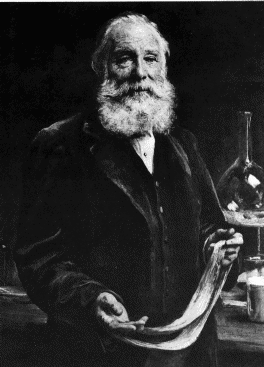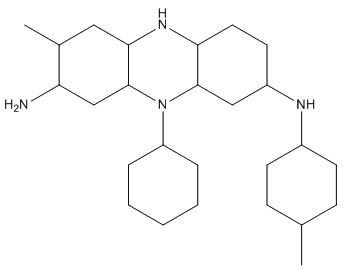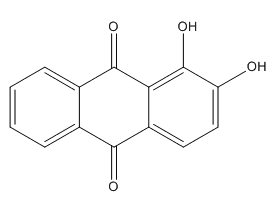Mauveine: The First Industrial Organic Fine-Chemical
Molecule of the Month - January 1996
Henry Rzepa, Department of Chemistry, Imperial College.
 |
Whilst the origin of the modern industrial revolution is often traced to the Ironbridge Gorge northwest of Birmingham in the UK, less credit is given to one of the birthplaces of the modern organic chemical industry. William Henry Perkin (1838-1907) who at the age of 18 had set out with idea of making quinine (C20H24N2O2) by oxidising allytoluidine (C10H12N), had accidentally produced instead the first ever synthetic dye aniline purple, better known as mauveine (actual formula of principal component C26H23N4+X-, X= sulphate, acetate, etc). It is worth noting that molecular structure of few compounds were known with certainty at this time, and even that of benzene had only recently been recognised by Kekule.
Perkin set up a factory (Perkin and Sons) on the banks of the Grand Union (then the Grand Junction) Canal in 1857 to produce it. This small dyeworks was located on a 6-acre site just south of the Black Horse public House, in Greenford, West London. This
pub survives to this day, and remains a "local" for the pharmaceutical giant, Glaxo SmithKline, which has its world headquarters nearby. |
At the Royal Exhibition of 1862, Queen Victoria made an appearance in a silk gown dyed with mauveine. In the Imperial College chemistry archives, there is a sample of silk (approx 5 x 10 cm in size) dyed with a batch of the original dye synthesised in the 1850s, and a "penny lilac" postage stamp originally thought to have been dyed with the same compound. Curiously, the "correct" structure for the compound was only finally put to rest as late as 1994 (appropriately enough, in a journal named after Perkin himself). This turns out to be a mixture of the compound shown and one other, alizarin, containing one more methyl group.
 |
 |
| Mauveine |
Alizarin |
The new colour fell out of fashion in the late 1860s, but out of one of the world's first chemistry "R&D" laboratories, Perkin discovered two new dyes, Britannia Violet and Perkin's Green (the water in the nearby Grand Union Canal was said to have turned a different colour every week - depending on what dyes were being made at the time). In 1869, Perkin synthesised the vivid natural red dye called Alizarin (known chemically as sodium 9,10-dihydro-3,4-dihydroxy-9,10-dioxoanthracene-2-sulfonate). The German company BASF beat him to the patenting process by one day! Perkin and BASF came to an agreement over the
manufacturing processes (Perkin would sell Alizarin to Britain, some 400 tons a year, BASF to the rest of the world) but the heyday of synthetic dye manufacturing in Greenford was now waning (allegedly because British universities were not producing sufficient numbers of chemists for the constant innovation now required in the dye industry) and in 1874, Perkin sold his dyeworks to Brooke, Simpson and Spiller. It continued operation under its new owners only until 1876, when
it was sold to the tar makers Burt, Boulton and Haywood, the dye operations of which joined the British Alizarine Company. This in turn became part of ICI in 1931, and in more modern times became known as Zeneca, a company which can claim to be the successor of Perkin.
Nowadays in Manchester, there remains a significant collection of interesting chemicals and other Perkin artefacts, although they are not on permanent public view. Other samples, including the original mauveine made by Perkin are located in the Science Museum, London, just next to Imperial College, and in the College archives themselves. Parts of the original Greenford buildings survived until the centenary celebrations in 1957, and the last traces were demolished as recently as 1976, the only remaining sign being the blue plaque erected on the buildings now there. Nowadays, the site of the laboratory for Perkin's dyeworks serves as a distribution point for millions of loaves of bread and rolls for West London. The Black Horse pub itself has recently been refurbished, and one can take a pleasure cruise along the Grand Union canal starting from the pub. The east-bound cruise can
take you to "Little Venice", in Paddington, which is about 3km north of Imperial College.
After he retired in 1874, Perkin continued research in organic chemistry, discovering the "Perkin Reaction", and perhaps most significantly, synthesising coumarin, which formed the basis of the synthetic perfume industry. He published some 60 research papers during this period, most of them in the Journal of the Chemical Society.
A Chemical Postscript
There is an interesting chemical postscript to the story of Mauveine. Essentially, its synthesis was remarkable because it was based on a one-pot (dichromate) oxidation of a simple (mixture) of aromatic (methyl)anilines, which are simple organic bases. Such bases are peculiarly prone to producing intriguing products in apparently simple reactions. Scorpionine was made recently in Charles Rees' group. Charles was the Hofmann Professor of Chemistry at Imperial College, and hence a successor to August Hofmann (1818-1892) who was Perkin's original supervisor and
inspiration, and first professor of the Royal College of Chemistry (founded in 1845, now Imperial College) which Perkin attended. Appropriately enough Charles is wearing a bow tie dyed with what is apparently a sample of the original mauveine made by Perkin himself, and is of course holding the journal named after Perkin. Scorpionine was made from the reaction of S2Cl2 with di-isopropyl ethyl amine, and is itself another so-called heteroaromatic compound, just like mauveine. Another simple base (DABCO, or di-aza-[2.2.2]bicyclo-octane) was discovered in Henry Rzepa's group to react with Bromine to give a very odd compound containing linear chains of 7 bromine ions, the chain having an overall charge of 3-. Both Scorpionine and the DABCO/Br2 adduct are highly coloured, just like mauveine, althogh neither appears to have any utility as a dyestuff.
A Postscript to the postscript
Further Information:
- The paper in which the correct structure was finally reported; O. Meth-Cohn and M. Smith, J. Chem. Soc., Perkin Transactions 1, 1994, 5.
- A small-scale synthesis of mauveine is reported by R. L. Scaccia, D. Coughlin, D. W. Ball, J. Chem. Ed, 1998,
75, 769.
- For a general account of the chemical history, see O. Meth-Cohn and A. S. Travis, Chemistry in Britain, 1995, 31, 547.
- Anthony S. Travis "The rainbow makers: the origins of the synthetic dyestuffs industry in Western Europe". Bethlehem: Lehigh UP, 1983.
- Henry S. Rzepa, Molecules, 1998, 3, 94-99.
- The Perkin Family Tree and History
- The Colour museum in Bradford and the Museum of Science and Industry in Manchester
- Mauve: "How One Man Invented a Color That Changed the World", by Simon Garfield, 2000.
- On line biography of Perkin, and some details of the chemistry of
mauveine.
Acknowledgements
I am particularly grateful to Dr Peter Morris of the Science Museum, London, for very helpful comments and corrections on the above history.
(c) H. S. Rzepa, 1995, 1998, 2001, 2004.

 Back to Molecule of the Month page.
Back to Molecule of the Month page.


